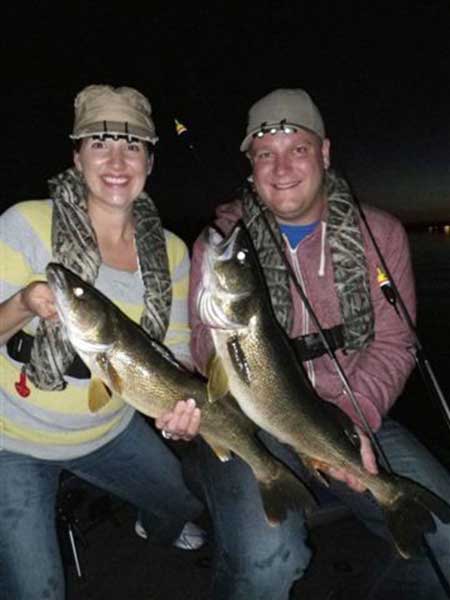(Provided by PRADCO Fishing)
 Try slip floats at night for walleyes.Walleyes have something in common with bats and owls theyre more suited to nighttime activities than the glare of the noonday sun. Theyd rather live in Moonglade than the Land of the Eternal Sunshine. Under certain conditions, such as following cold fronts, calm days or during unusually hot weather, walleyes are driven to the dark side by the bazillions.
Try slip floats at night for walleyes.Walleyes have something in common with bats and owls theyre more suited to nighttime activities than the glare of the noonday sun. Theyd rather live in Moonglade than the Land of the Eternal Sunshine. Under certain conditions, such as following cold fronts, calm days or during unusually hot weather, walleyes are driven to the dark side by the bazillions.
Spring through early summer, a slip-float rig is the way to go at night, and few anglers know more about it than Wisconsin walleye guide Greg Bohn. Bohn is the author of several books and articles on the subject, and over the years designed plenty of rods, floats, leaders, rigs and jigs for slip-bobber tactics.
The Thill Splash Brite really simplified slip-bobber fishing at night, Bohn said. It has electrodes that use the lake water to complete the circuit. When it hits the water, the light comes on. Pull it out of the water, and its off.
Bohn says night fishing tends to be good whenever conditions are bad for daytime fishing.
I love it when I hear the daytime crowd complaining, he said. That means the night bite will be hot. At night, we get for real bites. Walleyes wont drop it. I let the float go down until its almost out of sight.
Early-season night spots tend to involve emerging weedsfirst in shallow bays, then on shoreline-related points and sandbars, and finally on mid-lake humps. The first places Bohn looks in spring are bays 10-feet deep or less. Those bays will be choked out with weeds by mid summer. When weeds first appear, the growth is fairly uniform and easy to fish acrossperfect conditions for float fishing.
Another key involves finding the warmest water available. Bohn said that walleyes will travel great distances to find warm water early in the season, so he keeps a close eye on his temperature readout.
Fish are concentrated on those shoreline areas and walleyes are using the shallowest zones exclusively at night during the first half of the season, he said. There can be hundreds of walleyes shallow at night this time of year. Young minnows and perch never leave the weeds.
When fishing these emerging weedbeds, Bohn likes to keep his bait suspended a foot or two off bottom. He likes it to be over the walleyes heads so they can see it more easily and for the convenience of not constantly snagging in the weeds all the time.
Cold fronts, high bright skies, flat-calm conditions and a lot of sun or heat make daytime fishing tough, but set up for a productive night-bite. When walleyes are inactive during the day, they normally turn on when the sun goes down, but according to Bohn a lot of anglers leave too early, and that the most productive times can be from 10 p.m. until 2 a.m. He always likes the hour around sunset, but thats not what he calls night fishing. When he sees the daytime activity null, he prepares to stick it out for a long night.
Not all night are equal, though. Dead calm or post-frontal conditions can make the bite surge shorter in duration.
Bohns night fishing rig begins with 10-pound monofilament, a bobber stop and a Thill Night Brite or Splash Brite Slip Bobber.
Most of the time, Bohn prefers a lively minnow hooked through the skin between the dorsal fin and the tail.
When the bobber gets busy and starts to dance, theres a walleye looking at it, Bohn said. You see that a lot at night. Nervous minnows make the blade flash, and that triggers strikes.
Big winds and waves demand bigger bobbers and the ¼-ounce weight for proper balance, Bohn said, but he likes the smallest size float he can get away with. The smaller, lighter float means more freedom for the minnow.
Active walleyes, in stable conditions, dont mind chasing things down. When conditions drive them to the dark side early in the year, hang a suspended minnow over some emerging weeds.
Lighted slip-floating is fun, Bohn said, especially when they take off like a remote-controlled submarine.





